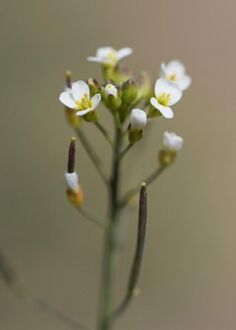Physics:Calcium signaling in Arabidopsis
Calcium signaling in Arabidopsis is a calcium mediated signalling pathway that Arabidopsis plants use in order to respond to a stimuli. In this pathway, Ca2+ works as a long range communication ion, allowing for rapid communication throughout the plant. Systemic changes in metabolites such as glucose and sucrose takes a few minutes after the stimulus, but gene transcription occurs within seconds.[1] Because hormones, peptides and RNA travel through the vascular system at lower speeds than the plants response to wounds, indicates that Ca2+ must be involved in the rapid signal propagation.[1] Instead of local communication to nearby cells and tissues, Ca2+ uses mass flow within the vascular system to help with rapid transport throughout the plant. Ca2+ moving through the xylem and phloem acts through a “calcium signature” receptor system in cells where they integrate the signal and respond with the activation of defense genes.[2] These calcium signatures encode information about the stimulus allowing the response of the plant to cater towards the type of stimulus.
Calcium wound/damage response
Different kinds of stimuli result in different responses within the Arabidopsis plant. A wound or damage to the plant causes a wound-activated surface potential (WASP) changes that serve as an alert message to undamaged tissues. This wound response results in a plasma membrane depolarization, H+ and Ca2+ efflux and K+ influx, causing an action potential. This action potential causes Ca2+ cytosolic concentration to increase, therefore sending calcium into the phloem, where the signaling is spread, and as it arrives to systemic tissues. Because of the various stimuli perceived by the plant, abiotic and biotic stress results in different amplitudes, durations, frequencies and localizations of Ca2+ concentrations. These “calcium signatures” encode information about the nature of the stimulus and different signatures are sensed by different sensor proteins.[2] With herbivory being an abiotic stressor, Ca2+ is sensed by the regulatory ubiquitin protein calmodulin, which phosphorylates JAV1. In turn, it ubiquitinates JAV1 so it no longer inhibits the biosynthesis of JA, giving a rapid increase of the JA hormone. This increase signals the defense system to begin transcribing JA inducible defense genes against herbivory.[3] Alert messages are generated and propagated throughout the plant to undamaged tissues through WASPs, Ca2+, and hormonal signals, such as JA.[2]
Calcium cold response
When an Arabidopsis plant is subjected to cold temperatures, it induces cold response genes. In order for cold genes to be expressed, COLD1 receptors that are present on the plants surface sense the cold temperature and activate Ca2+ channels, these channels include: MCA1, MCA2 and other undetermined channels. The activation of Ca2+ channels allows for Ca2+ to move into the cell and increase cellular Ca2+ concentration.[4] The concentration and duration of Ca2+ within the cell is determined by the plants acclimation to the temperature, as well as the intensity and length of cold duration.[5] During increased Ca2+ concentrations, Ca2+ is used as a second messenger to increase the concentration of Ca2+ dependent protein kinase (CPKs). During times of increased Ca2+ concentrations, Ca2+ also binds to calmodulin on the CRLK and AtSR1/CAMTA3. Activation of the CRLK causes an MAPK cascade that activates the MAPK pathway, signaling for the suppression of ICE1 degradation: ICE1 encodes a transcription factor that promotes production of CBF/DREB genes.[5] AtSR1 also binds to the promoter region of CBF and promotes CBF gene expression.[4] CBF and DREB transcription proteins are then synthesized and bind to the promoter of cold induced genes DRE and CRT.[6] Binding to the promoter region of the cold induced genes increases the rate of transcription of cold genes, allowing the Arabidopsis plant to become more acclimated to the cold. This Ca2+ signaling cascade, and transcription of cold genes in response to cold temperatures, allows for the plants survival.
References
- ↑ 1.0 1.1 "The fast and the furious: rapid long-range signaling in plants". Plant Physiology 185 (3): 694–706. April 2021. doi:10.1093/plphys/kiaa098. PMID 33793939.
- ↑ 2.0 2.1 2.2 "Wounding in the plant tissue: the defense of a dangerous passage". Frontiers in Plant Science 5: 470. 2014. doi:10.3389/fpls.2014.00470. PMID 25278948.
- ↑ "Injury Activates Ca2+/Calmodulin-Dependent Phosphorylation of JAV1-JAZ8-WRKY51 Complex for Jasmonate Biosynthesis". Molecular Cell 70 (1): 136–149.e7. April 2018. doi:10.1016/j.molcel.2018.03.013. PMID 29625034.
- ↑ 4.0 4.1 "Calcium Signaling-Mediated Plant Response to Cold Stress". International Journal of Molecular Sciences 19 (12): 3896. December 2018. doi:10.3390/ijms19123896. PMID 30563125.
- ↑ 5.0 5.1 "Cold induction of Arabidopsis CBF genes involves multiple ICE (inducer of CBF expression) promoter elements and a cold-regulatory circuit that is desensitized by low temperature". Plant Physiology 133 (2): 910–918. October 2003. doi:10.1104/pp.103.027169. PMID 14500791.
- ↑ "ICE1: a regulator of cold-induced transcriptome and freezing tolerance in Arabidopsis". Genes & Development 17 (8): 1043–1054. April 2003. doi:10.1101/gad.1077503. PMID 12672693.
 |


